Abstract
The effects of high temperatures (46 to 50 degrees C) on the production of F pili by Escherichia coli were studied by electron microscopy. Attached F pili rapidly disappeared at 48 and 50 degrees C but not at 46 degrees C. Free pili were not denatured at these temperatures. The pili that disappeared from the cells at 50 degrees C did not appear as free pili in the culture supernatant fluid, indicating that the pili had retracted to the cell surface or into the cell. The adsorption of either R17 phage or F pili antibody to the sides of pili prevented retraction. The disappearance of pili was accompanied by a loss in the ability to adsorb R17 phage but not M13 phage, suggesting that the tip of a pilus remains exposed after retraction.
Full text
PDF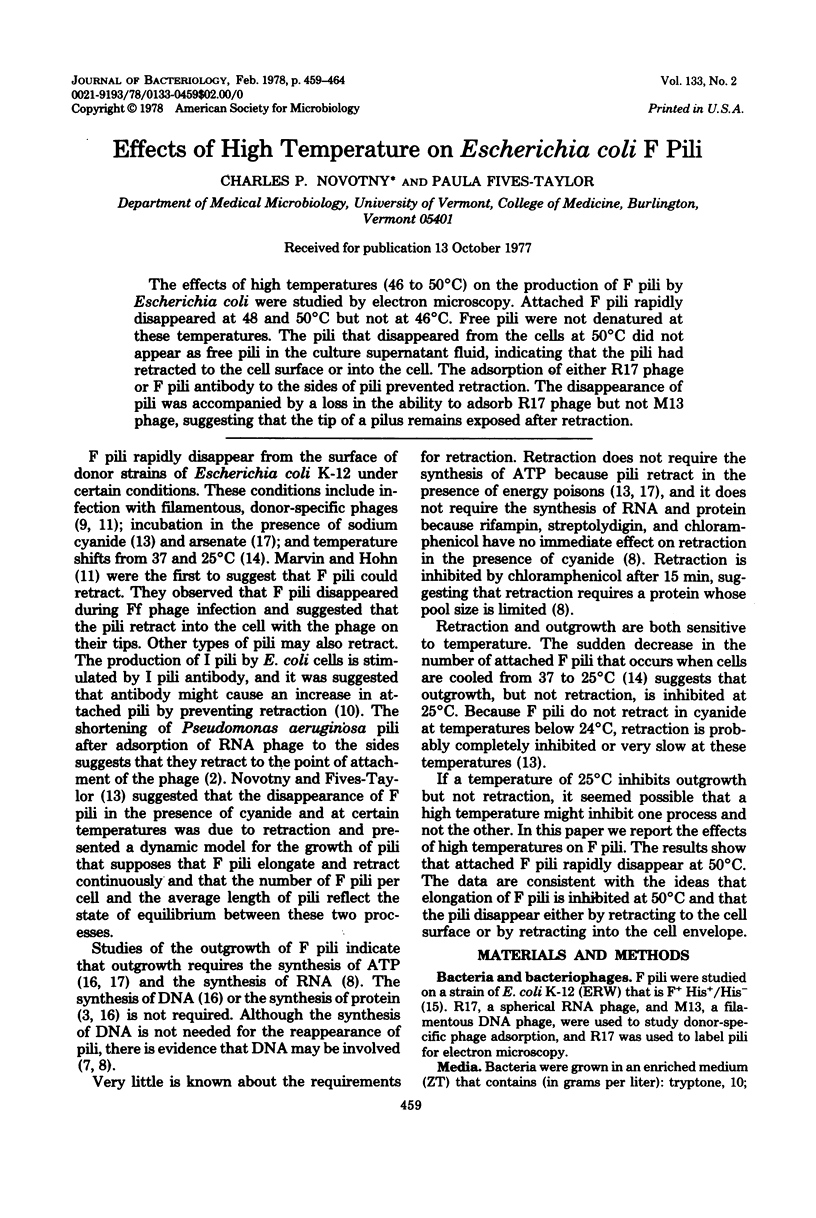
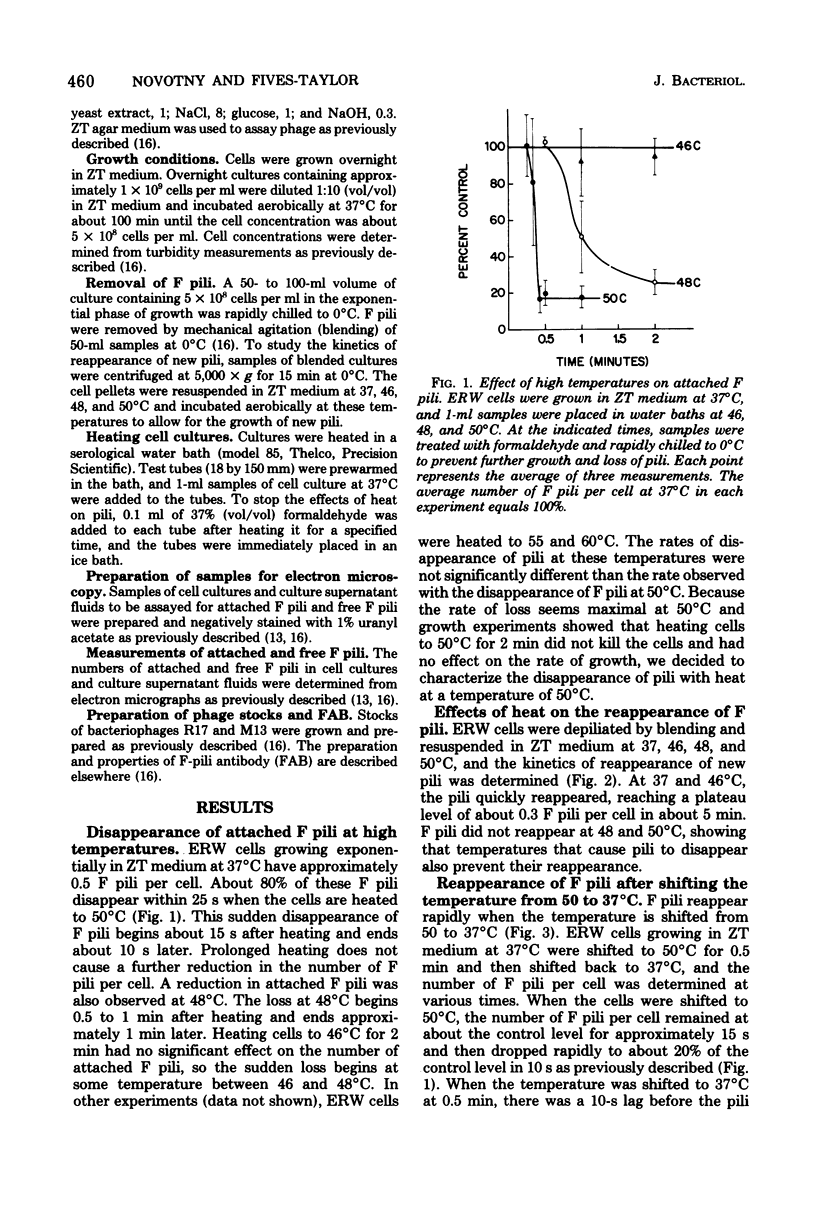
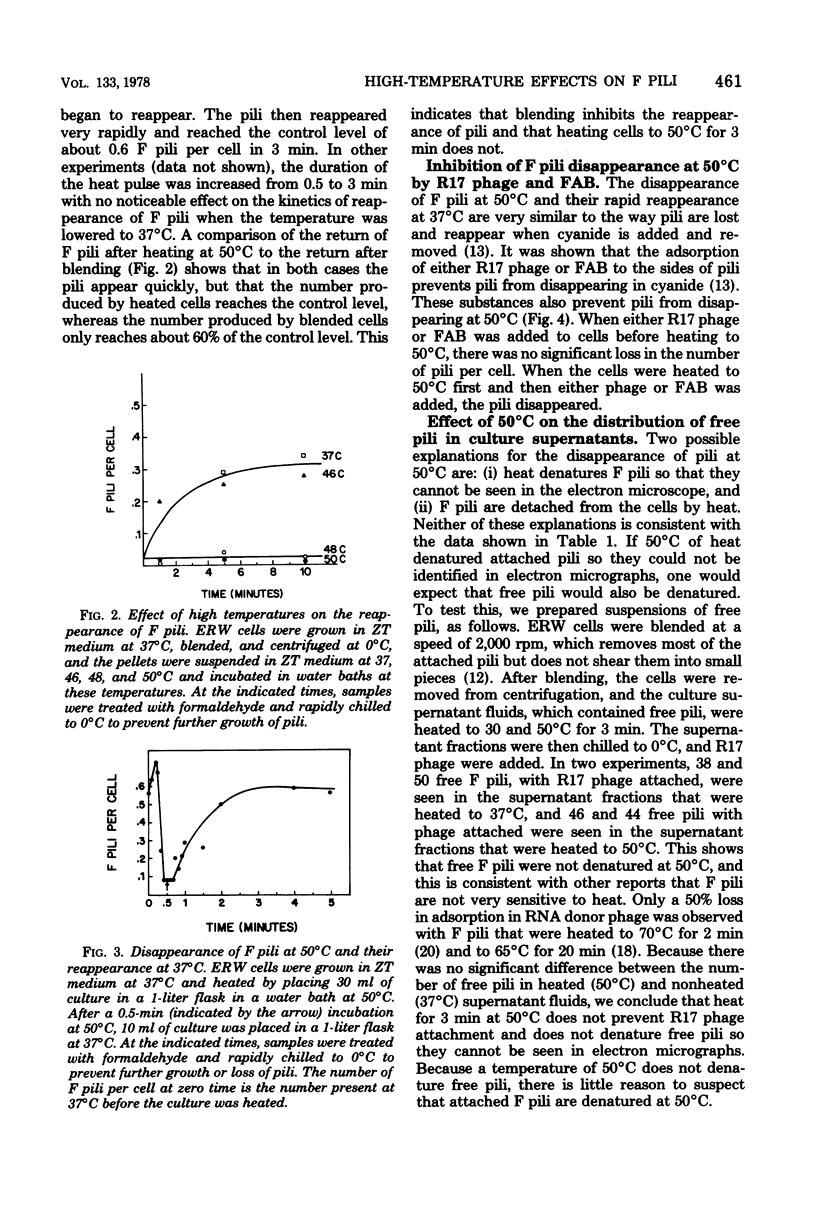
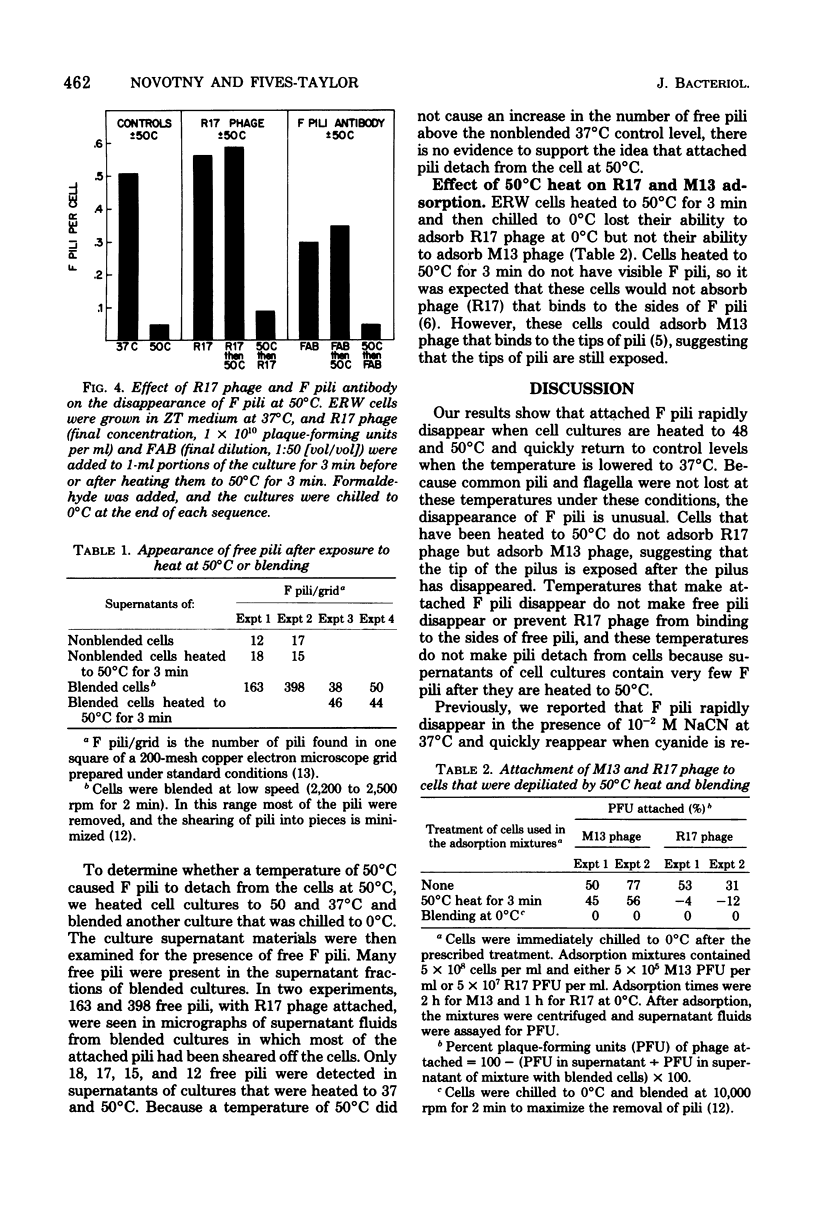
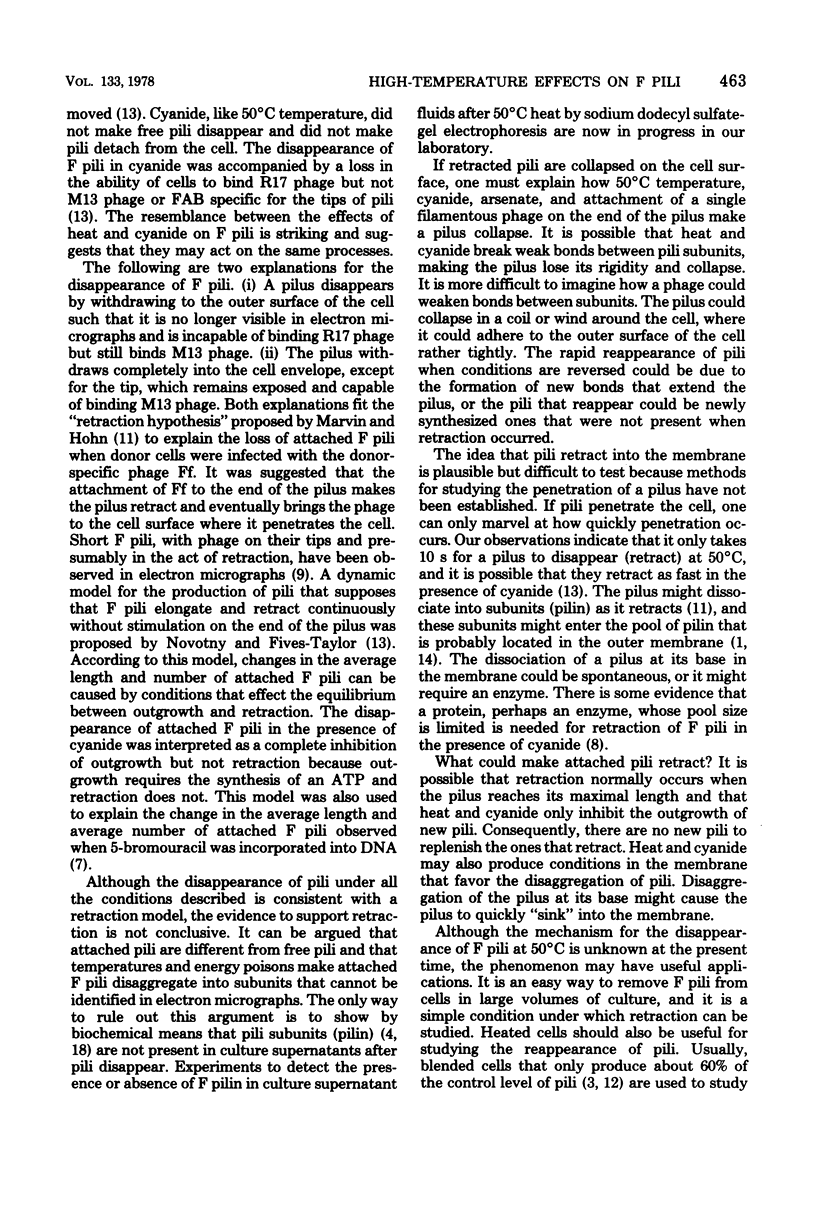
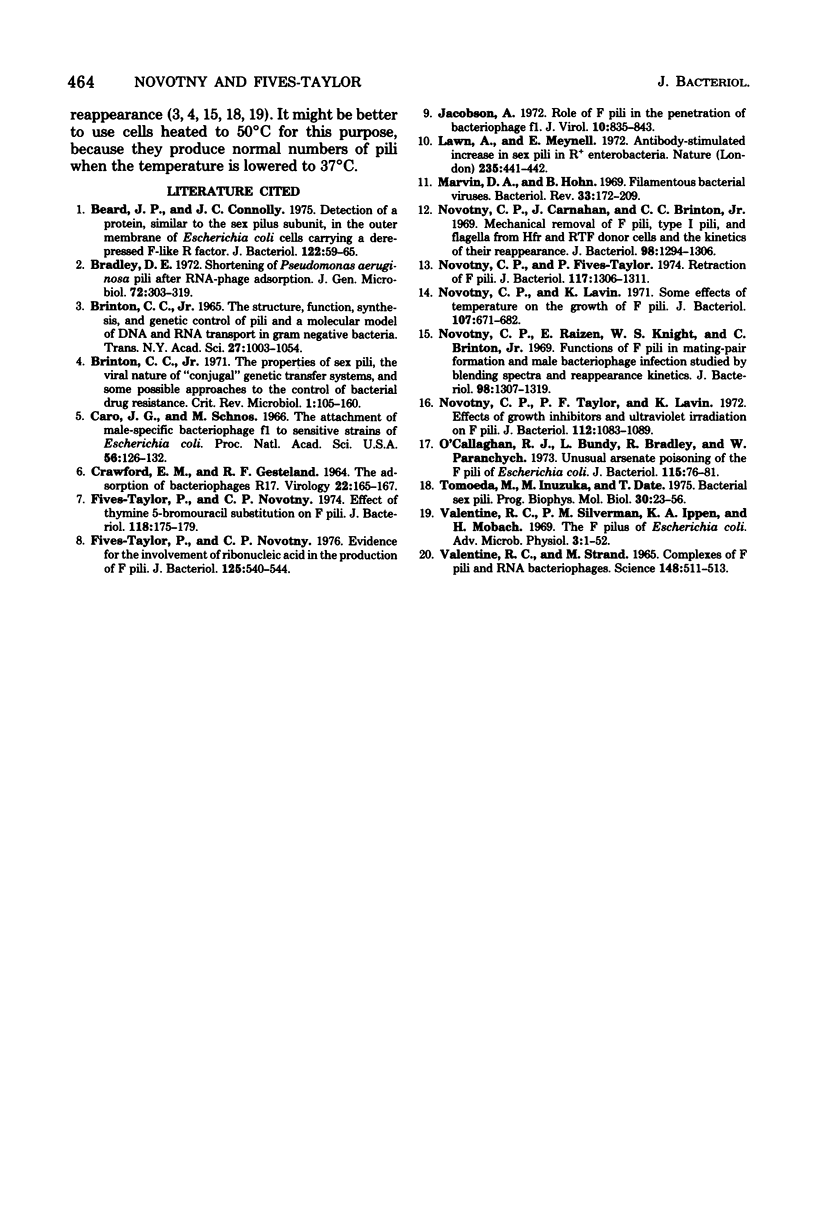
Selected References
These references are in PubMed. This may not be the complete list of references from this article.
- Beard J. P., Connolly J. C. Detection of a protein, similar to the sex pilus subunit, in the outer membrane of Escherichia coli cells carrying a derepressed F-like R factor. J Bacteriol. 1975 Apr;122(1):59–65. doi: 10.1128/jb.122.1.59-65.1975. [DOI] [PMC free article] [PubMed] [Google Scholar]
- Bradley D. E. Shortening of Pseudomonas aeruginosa pili after RNA-phage adsorption. J Gen Microbiol. 1972 Sep;72(2):303–319. doi: 10.1099/00221287-72-2-303. [DOI] [PubMed] [Google Scholar]
- Brinton C. C., Jr The properties of sex pili, the viral nature of "conjugal" genetic transfer systems, and some possible approaches to the control of bacterial drug resistance. CRC Crit Rev Microbiol. 1971 May;1(1):105–160. doi: 10.3109/10408417109104479. [DOI] [PubMed] [Google Scholar]
- Brinton C. C., Jr The structure, function, synthesis and genetic control of bacterial pili and a molecular model for DNA and RNA transport in gram negative bacteria. Trans N Y Acad Sci. 1965 Jun;27(8):1003–1054. doi: 10.1111/j.2164-0947.1965.tb02342.x. [DOI] [PubMed] [Google Scholar]
- Caro L. G., Schnös M. The attachment of the male-specific bacteriophage F1 to sensitive strains of Escherichia coli. Proc Natl Acad Sci U S A. 1966 Jul;56(1):126–132. doi: 10.1073/pnas.56.1.126. [DOI] [PMC free article] [PubMed] [Google Scholar]
- Fives-Taylor P., Novotny C. P. Effect of thymine-5-bromouracil substitution on F pili. J Bacteriol. 1974 Apr;118(1):175–179. doi: 10.1128/jb.118.1.175-179.1974. [DOI] [PMC free article] [PubMed] [Google Scholar]
- Fives-Taylor P., Novotny C. P. Evidence for the involvement of ribonucleic acid in the production of F pili. J Bacteriol. 1976 Feb;125(2):540–544. doi: 10.1128/jb.125.2.540-544.1976. [DOI] [PMC free article] [PubMed] [Google Scholar]
- Jacobson A. Role of F pili in the penetration of bacteriophage fl. J Virol. 1972 Oct;10(4):835–843. doi: 10.1128/jvi.10.4.835-843.1972. [DOI] [PMC free article] [PubMed] [Google Scholar]
- Lawn A. M., Meynell E. Antibody-stimulated increase in sex pili in R + enterobacteria. Nature. 1972 Feb 25;235(5339):441–442. doi: 10.1038/235441a0. [DOI] [PubMed] [Google Scholar]
- Marvin D. A., Hohn B. Filamentous bacterial viruses. Bacteriol Rev. 1969 Jun;33(2):172–209. doi: 10.1128/br.33.2.172-209.1969. [DOI] [PMC free article] [PubMed] [Google Scholar]
- Novotny C. P., Fives-Taylor P. Retraction of F pili. J Bacteriol. 1974 Mar;117(3):1306–1311. doi: 10.1128/jb.117.3.1306-1311.1974. [DOI] [PMC free article] [PubMed] [Google Scholar]
- Novotny C. P., Lavin K. Some effects of temperature on the growth of F pili. J Bacteriol. 1971 Sep;107(3):671–682. doi: 10.1128/jb.107.3.671-682.1971. [DOI] [PMC free article] [PubMed] [Google Scholar]
- Novotny C. P., Taylor P. F., Lavin K. Effects of growth inhibitors and ultraviolet irradiation on F pili. J Bacteriol. 1972 Dec;112(3):1083–1089. doi: 10.1128/jb.112.3.1083-1089.1972. [DOI] [PMC free article] [PubMed] [Google Scholar]
- Novotny C., Carnahan J., Brinton C. C., Jr Mechanical removal of F pili, type I pili, and flagella from Hfr and RTF donor cells and the kinetics of their reappearance. J Bacteriol. 1969 Jun;98(3):1294–1306. doi: 10.1128/jb.98.3.1294-1306.1969. [DOI] [PMC free article] [PubMed] [Google Scholar]
- Novotny C., Raizen E., Knight W. S., Brinton C. C., Jr Functions of F pili in mating-pair formation and male bacteriophage infection studies by blending spectra and reappearance kinetics. J Bacteriol. 1969 Jun;98(3):1307–1319. doi: 10.1128/jb.98.3.1307-1319.1969. [DOI] [PMC free article] [PubMed] [Google Scholar]
- O'Callaghan R. J., Bundy L., Bradley R., Paranchych W. Unusual arsenate poisoning of the F pili of Escherichia coli. J Bacteriol. 1973 Jul;115(1):76–81. doi: 10.1128/jb.115.1.76-81.1973. [DOI] [PMC free article] [PubMed] [Google Scholar]
- Tomoeda M., Inuzuka M., Date T. Bacterial sex pili. Prog Biophys Mol Biol. 1975;30(1):23–56. doi: 10.1016/0079-6107(76)90004-3. [DOI] [PubMed] [Google Scholar]
- VALENTINE R. C., STRAND M. COMPLEXES OF F-PILI AND RNA BACTERIOPHAGE. Science. 1965 Apr 23;148(3669):511–513. doi: 10.1126/science.148.3669.511. [DOI] [PubMed] [Google Scholar]


